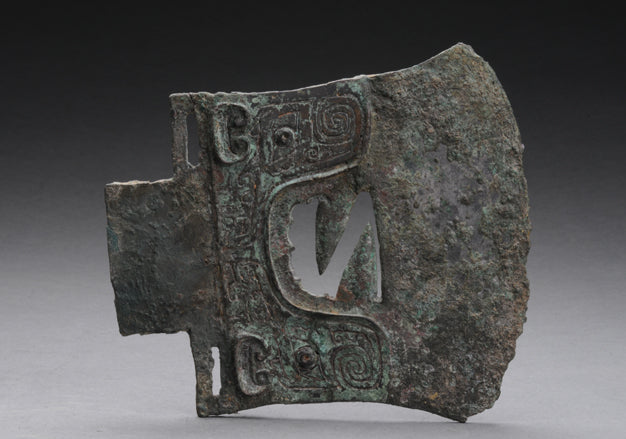
Bronze Axe with Animal Face Pattern

Bronze axe with animal face pattern, bronze ware, late Shang Dynasty, 17 cm long, 15 cm wide, 1.2 cm thick. Unearthed in Zhengzhou People's Park in 1954, now in Henan Museum.
In March 1954, the Henan Provincial Cultural Relics Team excavated Zhengzhou People's Park and unearthed a Shang Dynasty tomb group with dense burials and orderly arrangement in the central artificial Qingnian Lake area. The bronze axe with animal face pattern was unearthed in the tomb numbered C7M15 in the tomb group. The tomb belongs to the first phase of the Shang Dynasty People's Park and is a sacrificial tomb.
Bronze axe with animal face pattern (Figure 1), the axe body is thin and wide, the middle part of the body is inward-retracted, the two corners are outward-flashing, and the blade is curved. Flat shoulders, with a narrow and short rectangular inside behind the shoulders, and a rectangular hole on each shoulder. A group of animal face patterns are cast in the middle of the axe body, with two curled horns and protruding round eyes. The upper part of the hollow mouth has five small triangular sharp teeth, and the lower part has two staggered animal teeth, which are very fierce, and the forehead is decorated with Kui patterns.
Figure 1 Schematic diagram of the names of the various parts of the axe
From the perspective of the decoration, the animal face patterns on the body of the vessel follow the basic principle of symmetry of bronze decoration in the Shang and Zhou dynasties. This group of animal face patterns on the body of the vessel has thick and curved horns. Except for a small gap, it is almost bent into a rounded rectangle, forming a relief-like protrusion with the wide-open eyes (Figure 2). The lines of the Kui patterns on the corners of the eyes, eyebrows, nose, and forehead of the animal face are outlined with negative lines, which are delicate and exquisite. The semicircular snout at the bottom of the animal face pattern has teeth with concave patterns inside, and the patterns are raised, forming a hollow relief, which is exquisitely made (Figure 3). The animal head seems to be swallowing towards the person stabbed by the blade of the vessel, showing a fierce and intimidating deterrent momentum.
Figure 2: Protruding horns and eyes on the body of a beast-faced bronze axe

Figure 3: Eye corners, eyebrows and nose engraved in intaglio on the body of a beast-faced bronze axe
In November 2006, a beast-faced bronze axe was unearthed from the Shang Dynasty tomb M5 in the southeast of Guojiazhuang, Yinxu, Anyang City, Henan Province (Figure 4). The axe has flat shoulders and is rectangular. The axe body is longer than the shoulder width, and the two ends of the arc-shaped blade are upturned. The upper part of the axe body is decorated with a group of beast-face patterns, with protruding round eyes, thick and curved horns, and the teeth protruding in the concave pattern of the semicircular snout are in relief. A group of beast-face patterns are decorated on the inner back. The total length is 17 cm, the blade width is 11.5 cm, and the weight is 340 grams.
Figure 4 Bronze axe unearthed from the Shang Dynasty tomb M5 southeast of Guojiazhuang, Yinxu, Anyang City, Henan Province
This bronze axe unearthed from the C7M15 tomb of the first phase of Zhengzhou People's Park is similar in shape and decoration to similar axe unearthed from the tomb of the early late period of Yinxu, Anyang, Henan Province. Combined with the main pottery unearthed in the tomb, such as li, dou and gui, and compared with similar pottery unearthed from the tomb of the late Yinxu, Anyang, it is believed that this tomb belongs to the early late period of Shang Dynasty. This bronze axe is complete in shape, has been scientifically excavated, and has a clear excavation site. It provides a physical basis for the study of the periodization of Shang Dynasty sites in Zhengzhou and has certain research value.


![8.3"China Shang Dynasty,Bronze wine cup [Fuhao Jue cup][妇好爵杯]](http://bronzc.com/cdn/shop/files/4ee0482982cfa89bb4d1cff3333a55e6_e3ca0b86-22fc-497d-9afd-578c551225a3-2.jpg?v=1733986652&width=533)

![12.8" China Ming Dynasty, Phoenix-patterned bronze vase[Ming Wanli Phoenix-patterned vase][明万历凤纹瓶]](http://bronzc.com/cdn/shop/files/4ee0482982cfa89bb4d1cff3333a55e6_a516991b-2bb9-4b2f-a2b6-4354129d006c.jpg?v=1733986953&width=533)

![14.6" China Eastern Han Dynasty Bronze vessel in the shape of a flying horse,Also known as bronze galloping horse[Horse Stepping on Flying Swallow][马踏飞燕]](http://bronzc.com/cdn/shop/files/4ee0482982cfa89bb4d1cff3333a55e6_aa3fbeb8-e08b-4a44-929a-13411ca8fb17-2.jpg?v=1733987211&width=533)

![5.9"China Tang Dynasty, Bronze of a walking dragon[Tang Walking Dragon][唐走龙]](http://bronzc.com/cdn/shop/files/2_8cb416b9-ebbd-4fe2-a905-b9277f820c16.png?v=1731488701&width=533)
